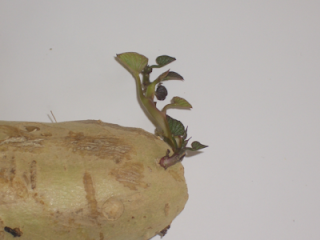Welcome back to another fine episode of Lost in the farmer’s
market where today we will be presenting the farmer’s market plant list early,
and talking about how to grow a specific vegetable that seems to be on a lot of
our fellow gardeners minds that’s right for today’s episode we will be talking
about growing potatoes. But before we get in to the fine art of growing your
own vodka plants, I’d like to take a moment to show you some shots from the
garden to show you gardeners out there some plants worth considering for your
own back yards.
 |
Pesto Purpetuo Basil is one of those basil varieties that
has sweet basil flavor but produces no flowers so all leaf all day all night.
You can get these plants out at Eastover
Garden Center.
|
Now on to the topic at hand; for today’s main topic I will
be discussing how to grow your own potatoes in your back yard. It is a common
misnomer that potatoes take up large amounts of space and are hard to grow. The
truth is that they are relatively easy but require special care and
considerations as well as for your own sake special placement so you can get at
your harvest bounty. The first thing to
know is that potatoes are not grown from planting tubers that have significant
amounts of growths emerging from the eyes. In fact those eyes and a little
slice of potato are what you want. Generally a potato left in a sunny window
long enough will sprout in a few weeks and that is how the home owner can get a
seedling potato. Now keep in mind some companies irradiate their tubers so they
cannot grow so you want to try and get a seed tuber from an organic source or a
farmer’s market.
 |
| This is representative of a white potato 'Slip' after some exposure to moisture and sunlight, note the eye growing roots. |
 |
| In comparison, a Sweet Potato, which is in a different family then white potatoes grows it's starting stems as seen. |
 |
| With a bit more exposure to moisture and soil medium a slip looks like this in about ten days. |
 |
| At fourteen days a potato slip's roots elongate greatly and the stems turn to find light. |
 |
| At 20 days the potato slip has a working root system and pretty much with care can produce other potatoes with time. |
Growing potatoes for your self is relatively easy, all you need to is provide plenty of room for the tubers, ample water and fertilizer. Protecting your crop from critters and pests is reasonably easy as most problems are very visible and can be remedied by any number of non-chemical means. Other possible methods to grow potatoes includes whiskey barrel planters, raised beds and this method as seen on the Urban farm tour some years ago.
the brick structure in the middle is a Potato chimney, it uses the same principle as the yam beds in the test gardens. A raised structure filled with the best soil possible that acts as a controlled environment to maximize production with minimized space. As a side note, that guy on the left doing all the pointing and talking, ignore him he's a total goofball.
This weekend you can come and speak to me in person at the
Fayetteville Farmer’s Market. The market is located on 325 Franklin Street and operates between
the hours of 9am and 1pm, though if last weekend was any indicator we were
there until almost 2pm. Barring significant rain I will be there and will have
cool and unusual stuff. In fact to that point in two weeks or so I will be
bringing Mountain Mint as one of the sale items. In case your not familiar,
Mountain Mint is a well-behaved mint relative with all the same uses as normal
mint except it grows rigidly upright.
Also I’ll be teamed up with the Sustainable neighbors, so
you can come on by the sustainability booth and get some good information about
sustainability, local foods, organics and heck even stuff about why GMO is so
bad. As promised here is the plant list of what will be available for sale at
the booth this week
Cucumbers &
Melons: Kiwano (1x), Armenian Cucumber (2x), Poona Kheera Cucumber (2x).
Leaf Greens:
Red-Leaf Amaranth (3x), Turkish Rocket (3x), Red Malabar Spinach (4x)
Herbs: Sweet
Basil (6x).
Ornamentals: Castor
Bean “Red Weed” (3x)
Fruit: Ground
Cherry “Cossack Pineapple” (1x).
Tomatoes: San
Marzano (4x), Mexican Midget (1x), Solar Fire (1x), Underground Rail Road (1x).
Eggplant: Nyakati
(3x), Early Black Egg (1x), Turkish Italian Orange
(2x), Louisiana Long Green (1x), Striped Togo
(1x)
Potatoes: Dark
Caribe (1x), Carola (5x)
Also I will have copies of Southward Skies Second Edition
available for purchase at the market. The book is 120 pages of gardening tips
tricks and information that is useful for gardeners of all skill levels. Each
book is $25.00 and of course at request you can get it signed and pose any
questions about it you’d like.
That said this wraps up another episode of lost in the
farmer’s market, we’ll continue to post cool stuff up here as it happens so
feel free to check back as the season progresses. Remember folks, all these
spring rains are nice but it also means the weeds and the lawn grow faster so
if your mower isn’t ready get set to kick some grass that aside as always keep
‘em growin!









No comments:
Post a Comment